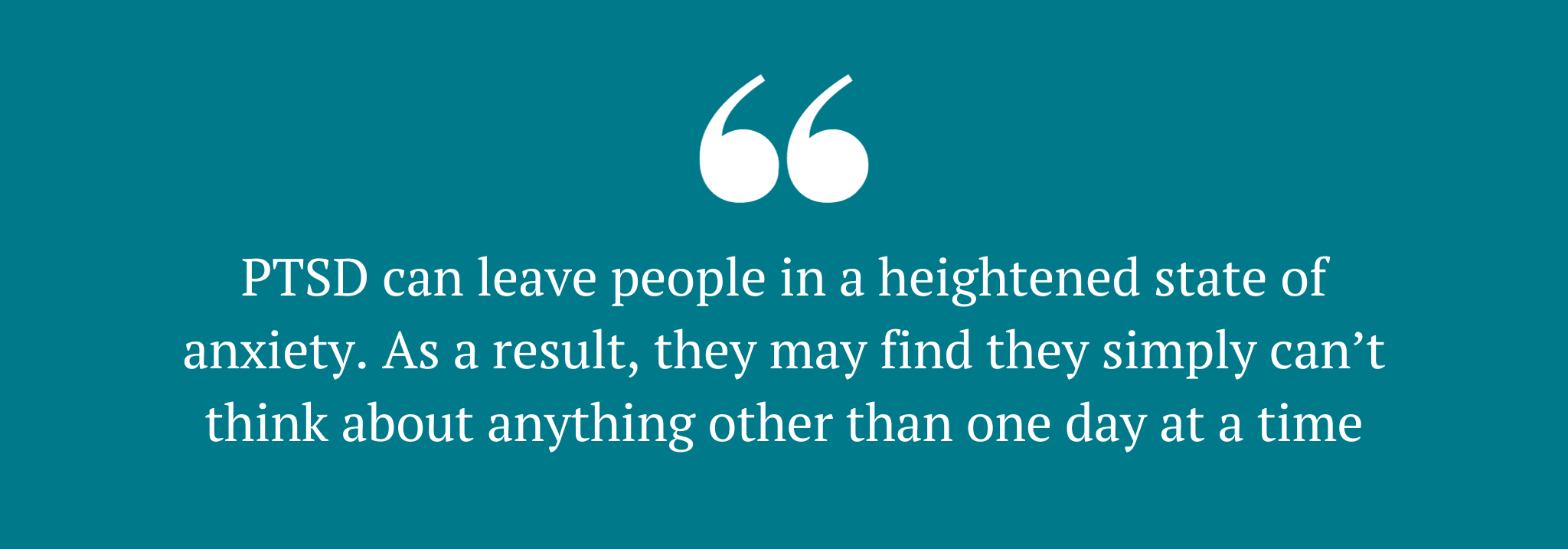Investigating an often overlooked symptom of PTSD, and steps we can take to address it
Where do you see yourself in five years? That’s the dreaded question that crops up everywhere from job interviews to first dates, and while you might have a rough idea of what you’re working towards, some post-traumatic stress disorder (PTSD) sufferers simply can’t imagine it.
Once thought to be something that only affected war veterans, PTSD is a mental health condition that can result from a variety of distressing experiences. Anything from the sudden death of a loved one, sexual abuse, or a natural disaster, to the COVID-19 lockdowns, could be the trigger. Thanks to celebrities like Ariana Grande, Scarlett Curtis, and Lady Gaga sharing their stories, the general population are now beginning to understand the complexities of the condition.
You’re probably already aware that people with PTSD often experience debilitating symptoms including flashbacks, nightmares, physical pain, hyperarousal, and addiction issues. But one lesser-known symptom of the condition is a sense of a foreshortened future.
What is a sense of a foreshortened future?
For a lot of people, thoughts of the future bring a sense of excitement and anticipation. But for some PTSD sufferers, the concept of creating one’s future is incomprehensible – terrifying, even – because they believe they have no future to look forward to.
Because of their painful past, people who experience this symptom may have a sense that they won’t live long, that their lives will be cut short, and they won’t reach certain societal milestones such as going to university, getting married, or having a family. Some people describe it as a deep knowing that death is imminent, while others say it’s a fleeting thought that paints a bleak or blurry future.
Why is it a problem?
The impact of a sense of a foreshortened future shouldn’t be downplayed. It’s a perspective on life that can permeate someone’s ability to find career satisfaction, healthy relationships, and a complete sense of self. Without any faith that tomorrow will arrive, they get stuck in a state of neverending hopelessness which can lead to avoidance behaviours such as substance abuse, reckless spending, and social isolation. It’s important to understand that this isn’t the person’s fault, but rather the manifestation of such deep-rooted self-doubt that they literally feel incapable of surviving.

Why does it happen?
If the traumatic experience came with a loss of control, then the uncertainty of the future might trigger painful feelings that mirror those from the initial trauma. Engaging in conversations or thoughts about the future can recreate those painful fears, so avoiding them maintains a sense of control. Additionally, PTSD can leave people in a heightened state of anxiety, which can be mentally and physically exhausting. As a result, they may find they simply can’t think about anything other than one day at a time.
This type of avoidance is a result of very real pain, one that is aimed at preventing further emotional distress. In theory, it can serve as a way for individuals to emotionally protect themselves from the uncertainty and potential disappointment that the future may hold. By holding a pessimistic view at all times, there is less risk of being hurt when things don’t turn out well. In practice, it can keep a person trapped in the past and unable to live a fulfilling life.
Treatment options
Thankfully, there are helpful coping mechanisms available to soothe symptoms and nurture optimism for the future. Kamalyn Kaur, a psychotherapist and anxiety expert, suggests trying evidence-based therapy such as cognitive behaviour therapy (CBT) or eye movement desensitisation and reprocessing (EMDR).
“This can help address the underlying trauma and work through any negative or catastrophic thoughts related to the future,” explains Kamalyn. “These therapies will help you rationalise negative thoughts, so that you don’t go into a negative spiral of thoughts.”
There is also the option of somatic therapy, an approach that focuses on the physical sensations that can live in the body after a traumatic event. By observing and processing these sensations, you can safely move out of survival mode, and heal from the trauma. Because this form of therapy can involve physical touch and sensations that may trigger flashbacks, it’s important that you find a trained therapist to support you through this work.
Write it out
In the comfort of your own home, journaling can help you process feelings and keep you anchored safely in the present. Try writing about the good things that have happened in your recent past, such as earlier today or yesterday. Try to slow down your thinking and focus on exactly where you are right now, journaling about the pleasant feelings in your body as well as any sounds, smells or sights you can observe. Who makes you feel seen? Write about them and explore why they make you feel better, taking time to express gratitude either in your journal or by letting them know personally.

Connect with people you trust
Because a foreshortened future can lead to feelings of shame, inadequacy and social isolation, surrounding yourself with people who make you feel good about yourself is key. Understandably, isolating yourself might feel like the only way to remain safe, but when you’re alone you’re more likely to experience intrusive thoughts, flashbacks, and more intense fears about the future.
This doesn’t mean you need to be out seeing friends every night of the week, just be aware of your tendency towards isolation, try to connect regularly with friends and family, and note the positive impact it has on your general wellbeing. It can be helpful to explain your symptoms to friends so that they understand the importance of social time, and always remember to set boundaries on what you’re comfortable with.
Baby steps
Actively working towards something that genuinely scares you is a big deal. Be kind to yourself and, when you’re ready, try setting small goals to familiarise yourself with the process. Start small, by setting a tiny goal for the day, e.g. drinking three glasses of water, or reading two pages of a book. These small wins are a step in the right direction, and prove that you are making progress towards building a happy future.
“Setting and achieving small goals will help give you a sense of accomplishment, purpose, and fulfilment,” says Kamalyn. “Furthermore, the completion of these goals should be acknowledged and celebrated regardless of how minor they might be, as this can aid with a more positive and hopeful outlook for the future.”
Kamalyn Kaur is a psychotherapist and anxiety expert (kamalynkaur.com).


Comments